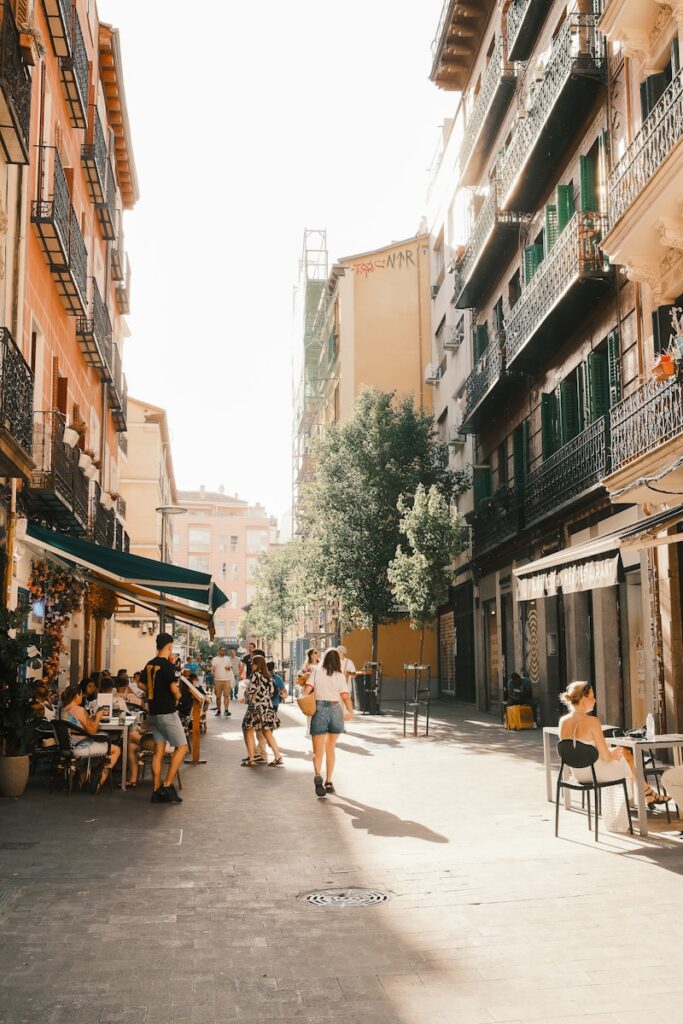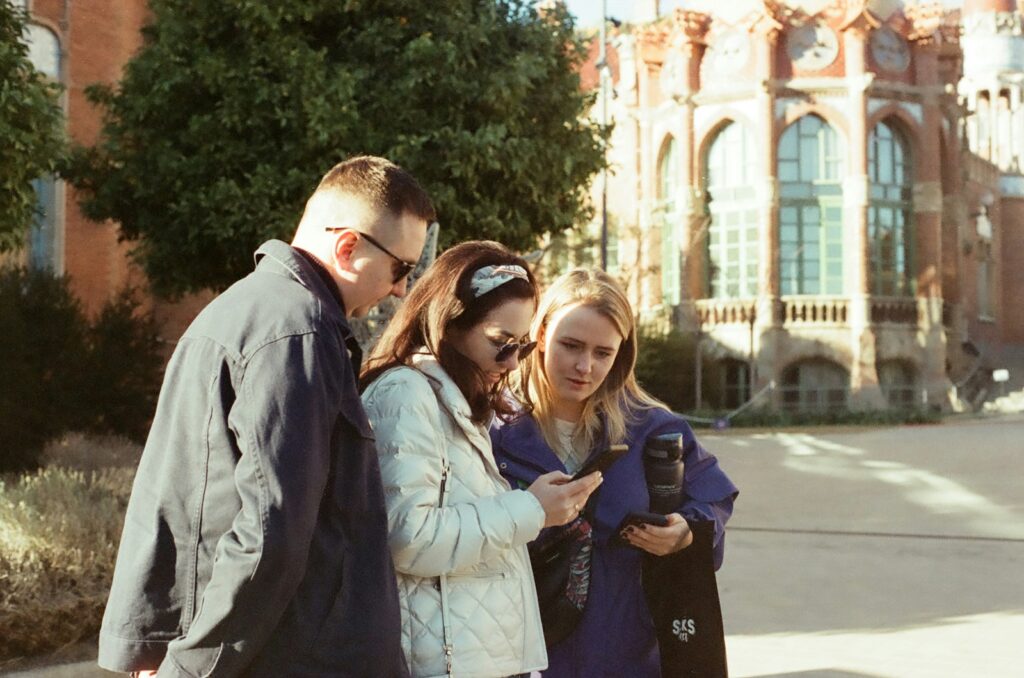How to say “May I” in Spanish: A Deep Dive
Imagine you’re in a cozy café in Madrid, the aroma of freshly brewed coffee filling the air. You want to ask the barista if you may have a slice of that delicious-looking cake behind the counter. But how do you politely ask in Spanish? The phrase “May I” can be a bit tricky when you’re trying to navigate a new language, but don’t worry—I’ve got your back.
When you need to say “May I” in Spanish, you typically use “¿Puedo?” or “¿Podría?”. These phrases can open doors, quite literally, whether you’re requesting permission to enter a room or simply asking for a favor. Mastering these simple yet powerful words can make your interactions smoother and more enjoyable.
“¿Puedo?” – The Most Common Way to Say “May I” in Spanish
Looking to blend into Spanish-speaking cultures? Mastering ¿Puedo? is key. This phrase helps ask for permission gracefully, just as effectively in Barcelona as in Buenos Aires.
Understanding the Verb “Poder” (to be able to)
The verb poder means “to be able to” or, contextually, “to can”. It’s an essential verb for asking permission, much like “may” in English. Knowing how and when to use poder can help you navigate daily interactions smoothly.
Conjugation of “Poder” in Present Tense
To use ¿Puedo? correctly, the present tense conjugation of poder is vital. Here’s a quick reference:
Subject | Conjugation |
|---|---|
Yo | puedo |
Tú | puedes |
Él/Ella/Usted | puede |
Nosotros/as | podemos |
Vosotros/as | podéis |
Ellos/as | pueden |
Master these forms to ask for permissions in varied contexts.
Using “¿Puedo?” in Everyday Situations
Asking for Permission
When you need to ask for permission, ¿Puedo? fits perfectly. Imagine you’re at a friend’s house and want to use their restroom. You’d say, “¿Puedo usar el baño?” (May I use the bathroom?). This keeps things polite and shows respect for others’ space.
Making Polite Requests
For polite requests, ¿Puedo? also shines. At a café in Madrid, ordering another coffee politely, you might say, “¿Puedo tener otro café?” (May I have another coffee?). This simple phrase can make your interactions smoother.
Regional Variations of “¿Puedo?”
Regional variations of ¿Puedo? are minimal. Whether in Mexico or Argentina, this phrase remains widely understood. But, regional manners and customs can add flavor. In some places, adding por favor (please) at the end makes it even more courteous, like “¿Puedo entrar, por favor?” (May I come in, please?).
Exploring Spanish-speaking cultures becomes easier with ¿Puedo? in your linguistic toolkit. Use it to show respect and keep interactions pleasant.
Alternative Expressions for “May I” in Spanish
Mastering different ways to ask for permission in Spanish is essential as it helps you navigate social interactions more smoothly. Politeness and context play important roles. From a professional setting to a casual hangout, here’s how you can say “May I” in a variety of ways.
“¿Me Permite?” (Would You Allow Me?)
Ever been in a situation where formality is the key? ¿Me permite? is what you need. This phrase is quite polite and direct. Imagine you’re at a business meeting in Mexico City, and you need to excuse yourself briefly. Ask, ¿Me permite? This shows respect and politeness, crucial in professional environments.
“¿Está Bien Si…?” (Is It Okay If…?)
For a casual vibe, ¿Está bien si…? fits perfectly. Picture yourself at a friend’s BBQ in Buenos Aires, and you want to grab a drink from the fridge. Say, ¿Está bien si tomo una bebida? It’s casual yet courteous. Friends and acquaintances will appreciate this comfortable yet respectful approach.
“¿Le/Te Importa Si…?” (Do You Mind If…?)
Think about using ¿Le/Te importa si…? when you need to be both polite and considerate. For instance, at a dinner party in Spain, you want to switch seats with someone. Ask, ¿Te importa si cambio de asiento contigo? This phrase works wonders in situations requiring a touch of empathy and politeness.
“¿Sería Posible…?” (Would It Be Possible…?)
Heading into a super formal scenario? ¿Sería posible…? is your go-to phrase. Imagine you’re attending a conference and need a special request fulfilled. Say, ¿Sería posible obtener una copia del informe? This phrase conveys professionalism and deference, perfect for high-stakes environments.
Here’s a quick summary in a table to make it simpler:
Phrase | Translation | Context | Example |
|---|---|---|---|
¿Me permite? | Would you allow me? | Formal | ¿Me permite? (Would you allow me?) |
¿Está bien si…? | Is it okay if…? | Casual | ¿Está bien si tomo una bebida? (Is it okay if I take a drink?) |
¿Le/Te importa si…? | Do you mind if…? | Polite/Caring | ¿Te importa si cambio de asiento contigo? (Do you mind if I switch seats with you?) |
¿Sería posible…? | Would it be possible…? | Highly Formal | ¿Sería posible obtener una copia del informe? (Would it be possible to get a copy of the report?) |
Formal vs. Informal Ways to Say “May I” in Spanish

Exploring the nuances of formal and informal speech in Spanish can feel like decoding a secret language. Knowing when to use each form shows respect and understanding, and it sets a solid foundation for effective communication.
Formal Situations: Using “Usted” Form
When in professional settings or addressing someone with higher social status, like a senior colleague or elderly person, use the formal form. It conveys respect and keeps interactions professional.
Examples:
“¿Podría…?” (Could I…?)
“¿Podría…?” is a polite way to ask for permission. It mirrors the English “Could I…?” and is perfect for maintaining a respectful tone.
Imagine you’re in a business meeting and you need to turn on the projector. You’d say “¿Podría encender el proyector?” This shows politeness and maintains the formal atmosphere.
“¿Me permitiría…?” (Would you allow me…?)
For even more formality, “¿Me permitiría…?” works wonders. It translates to “Would you allow me…?” and lends an air of utmost respect.
Visualize you’re speaking to a dignitary, needing to ask a question. Use “¿Me permitiría hacer una pregunta?” showing your high regard for their status.
Informal Situations: Using “Tú” Form
Casual settings call for a relaxed tone. When hanging out with friends or family, the informal form is your go-to. It keeps the conversation light and personable.
Examples:
“¿Puedo…?” (Can I…?)
Use “¿Puedo…?” as a straightforward, friendly way to ask “Can I…?” It’s direct and easy to use with anyone you feel comfortable with.
You’re at a friend’s house and want to grab a drink from the fridge. Simply ask, “¿Puedo tomar algo de la nevera?” Casual, simple, and clear.
“¿Me dejas…?” (Will you let me…?)
For an even lighter touch, “¿Me dejas…?” fits the bill. Meaning “Will you let me…?”, it works great among close companions.
Imagine needing to borrow a pen from a buddy during class. Say, “¿Me dejas un bolígrafo?” It keeps things easy-going and familiar.
When to Use Each Form
Understanding when to switch between formal and informal forms solidifies your command over the language in any context.
Professional Settings
In offices or official places, stick with formal expressions like “¿Podría…?” or “¿Me permitiría…?” These keep interactions professional and respectful.
Picture needing to ask your supervisor for a project update. Saying “¿Podría darme una actualización del proyecto?” upholds the workplace decorum.
Family and Friends
When with close friends and family, informal forms like “¿Puedo…?” or “¿Me dejas…?” are ideal. They foster a warm and familiar environment.
Think about asking your cousin if you can use their laptop, saying “¿Puedo usar tu laptop?” makes the request friendly and laid-back.
Age and Social Status Considerations
Formal forms are best used with those older or of higher social status. Informal forms are suitable for peers or those younger than you.
If speaking to your grandmother, default to “¿Me permitiría ayudarle?” for respect. For a classmate, use “¿Me dejas ver tus apuntes?” for a friendly tone.
Common Phrases Using “May I” in Spanish

When you’re learning Spanish, knowing how to politely ask for permission can be a game-changer. Using phrases like ¿Puedo? places you miles ahead in terms of sounding respectful and integrating seamlessly into Spanish-speaking environments. Let’s investigate into some essential phrases you can use.
¿Puedo pasar? (May I come in?)
Imagine you’re at a friend’s house or a business meeting. You’d knock on the door and say, ¿Puedo pasar? It’s the perfect way to ask if it’s alright to enter. This phrase is universally understood and essential for ensuring you’re not intruding.
¿Me permite hablar? (May I speak?)
In situations where you’d like to talk, maybe during a meeting or a dinner conversation, you can use ¿Me permite hablar? It’s polite and shows that you respect the current speaker. This phrase instantly demonstrates your manners and makes you appear considerate.
¿Puedo hacer una pregunta? (May I ask a question?)
When you’re unsure about something, asking ¿Puedo hacer una pregunta? shows you value the other person’s input and knowledge. Whether you’re in class, at work, or just chatting, this phrase makes your requests seem more thoughtful.
¿Sería posible tener un momento? (May I have a moment?)
Sometimes, you need a brief moment to discuss something important. Using ¿Sería posible tener un momento? is a polite way to request someone’s time. It suggests urgency and respect, making your request hard to ignore.
Phrase | English Translation | Use Case |
|---|---|---|
¿Puedo pasar? | May I come in? | Asking to enter a room or space when the door is closed. |
¿Me permite hablar? | May I speak? | Seeking permission to talk during a conversation or a meeting. |
¿Puedo hacer una pregunta? | May I ask a question? | Requesting to ask a question in various formal or informal settings. |
¿Sería posible tener un momento? | May I have a moment? | Asking for a brief period to discuss or address something important. |
Cultural Context of Using “May I” in Spanish-Speaking Countries
Asking for permission politely in Spanish-speaking countries goes beyond grammar—it’s about cultural connection and respect. Politeness isn’t optional; it’s essential in social interactions. Understanding this elevates how you communicate in these vibrant cultures.
Importance of Politeness in Hispanic Cultures
In Hispanic cultures, politeness is more than just good manners; it’s a fundamental part of everyday life. Have you ever noticed how shopkeepers in Spain engage in lively conversations with customers? This isn’t just friendliness; it’s a cultural expression of warmth and respect.
In Puerto Rico, service interactions often use hearer-oriented verb forms, emphasizing you rather than I. This shows respect and consideration for the other person, making every exchange more personal and polite. Whether you’re in a café or a boutique, using polite language like ¿Puedo entrar? (May I enter?) creates harmony and mutual respect.
Regional Differences in Using “May I”
Each Spanish-speaking country has its own way of expressing politeness. For instance, ¿Puedo? is common across all regions, but you’ll find variations that add local flavor.
Examples:
These nuances might seem subtle, but they’re crucial for building rapport and showing respect to locals. Embrace these differences to make your interactions smoother and more culturally appropriate.
Non-Verbal Cues When Making Polite Requests
Words are powerful, but non-verbal cues play a significant role too. Would a smile, eye contact, or a gentle nod make a difference? Absolutely!
In Spanish-speaking communities, maintaining eye contact and using a gentle tone reinforces your respect and politeness. A warm smile when asking ¿Me permite hablar? (May I speak?) shows sincerity and makes your request more likely to be welcomed.
Combining polite phrases with the right non-verbal cues can transform a simple request into a respectful, culturally aware interaction.
By using these key pointers, you’ll navigate social encounters in Spanish-speaking countries with ease, demonstrating both linguistic competence and cultural awareness.
Tips for Using “May I” in Spanish Conversations

Exploring Spanish conversations requires politeness, especially when asking for permission. Let’s jump into some tips to smoothly integrate “May I” phrases into your interactions.
Combining “May I” with Other Polite Expressions
Blending “May I” with polite expressions in Spanish enhances respect. Consider these combinations:
For example, use ¿Puedo… combined with gracias to show appreciation, like asking to speak in Spanish: ¿Puedo hablar en español, gracias? This small addition promotes politeness.
Contextual Sensitivity
Understand contexts. If you’re in a casual setting with friends, ¿Puedo… works well. In a formal setting, ¿Podría… adds politeness. Context influences your word choice.
Examples:
Non-Verbal Cues
Non-verbal cues like eye contact and a gentle tone matter. They reinforce your respect and politeness.
- Maintain eye contact: Demonstrates sincerity.
- Use a gentle tone: Sounds more respectful.
Imagine asking a shopkeeper, ¿Me permite…? (Do you permit me…): If spoken softly with eye contact, it feels more genuine.
Combining Phrases for Maximum Effect
Combining phrases shows effort and respect. Mix and match:
Examples:
Providing Context
Offering context helps. Explain why you’re asking or what you hope to achieve. This shows consideration.
Examples:
Sample Phrases in Various Scenarios
Here’s a quick reference of polite “May I” phrases for different settings:
Scenario | Phrase | Example |
|---|---|---|
Asking permission | ¿Puedo…? | ¿Puedo practicar mi español contigo? |
More formal request | ¿Podría…? | ¿Podría hablar en español? |
Asking if it’s okay | ¿Te importa si…? | ¿Te importa si practico mi español aquí? |
Formal setting | ¿Le importa si…? | ¿Le importa si hablo en español? |
These phrases, combined with non-verbal cues, context, and politeness, help you navigate Spanish conversations with ease.
Common mistakes to avoid when using “May I” in Spanish

When you’re learning to say “May I” in Spanish, it’s easy to make a few common mistakes. These can lead to misunderstandings or make you sound less polite than intended. Let’s explore some pitfalls to watch out for and ensure you confidently ask for permission.
Direct Translation
A big mistake many learners make is directly translating “May I” to Mayo. While this may seem logical, Mayo actually translates to the month of May. Using phrases like ¿Puedo…? (Can I…?) or ¿Podría…? (Could I…?) is the correct way to ask for permission.
Formal vs. Informal
It’s crucial to match the level of formality to the context. Informal settings, like chatting with friends, suit ¿Puedo…? better, while ¿Me permite…? (May I have…?) or ¿Podría…? work best in professional or formal environments. Mixing them up can come off as either too casual or overly stiff.
Regional Variations
Spanish is spoken in many countries, and nuances can change regionally. What works in Spain might not be as common in Mexico or Argentina. Always strive to learn the regional variations to avoid any awkward situations.
Here’s a quick table to help you remember:
Context | Preferred Phrase | Example Usage |
|---|---|---|
Informal | ¿Puedo…? | ¿Puedo usar tu teléfono? (Can I use your phone?) |
Formal | ¿Me permite…? | ¿Me permite pasar? (May I come in?) |
Formal | ¿Podría…? | ¿Podría ayudarme? (Could you help me?) |
Conclusion: Mastering “May I” in Spanish for Effective Communication
Learning how to say “May I” in Spanish can truly enhance your interactions and show respect in Spanish-speaking cultures. By understanding the nuances and regional differences, you’ll navigate conversations more smoothly and avoid common pitfalls. Remember to match the formality level to the situation and pay attention to non-verbal cues. With practice and awareness, you’ll find yourself more confident and effective in your Spanish communication. So go ahead and integrate these tips into your daily conversations and watch your language skills blossom!
Frequently Asked Questions
What does “¿Puedo?” mean?
“¿Puedo?” translates to “May I?” in English. It’s a polite way to ask for permission in Spanish.
How do you ask for permission politely in Spanish?
To ask for permission politely, you can use “¿Puedo?” or the more formal “¿Podría?”. Both phrases emphasize respect and courtesy.
Are there regional differences in asking for permission in Spanish?
Yes, regional variations exist. While “¿Puedo?” is universally understood, some regions prefer phrases like “¿Podría?” or “¿Me permites?”.
What are common mistakes when asking for permission in Spanish?
Common mistakes include direct translation from English, ignoring formality levels, and not considering regional variations.
How important are non-verbal cues in Spanish-speaking cultures when asking for permission?
Non-verbal cues are very important. Gestures, facial expressions, and tone of voice can significantly impact how your request is received.
Is it always necessary to be formal when asking for permission in Spanish?
It depends on the context. In formal settings, using “¿Podría?” is recommended. In casual settings, “¿Puedo?” is usually acceptable.
Can you provide an example of asking for permission in a formal setting?
Certainly! In a formal setting, you can say “¿Podría usar su teléfono?” which means “May I use your phone?”.






